Extremely Rare Farquhar's Celestial Globe Of Night Hailey's Comet Edition
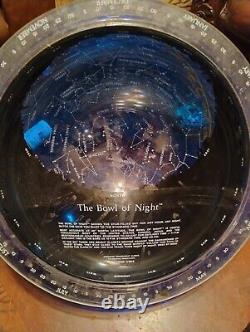
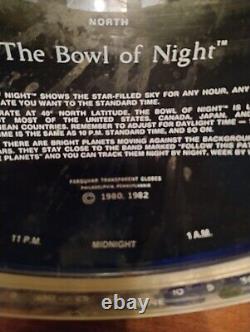


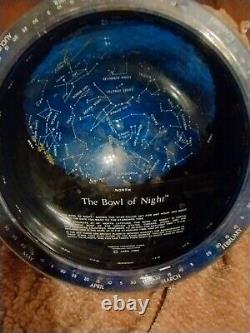
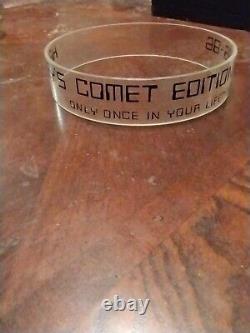
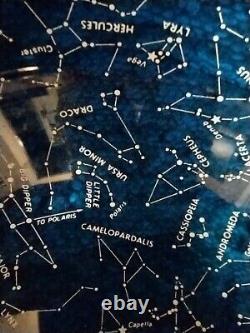

The story begins in the mind of a man dear to children worldwide: Hans A. Rey, creator of the Curious George series of books. As well as authoring the adventures of a small, inquisitive monkey, Rey, having an interest in astronomy, wrote several books on the subject, his most well-known being The Stars - A New Way To See Them, first published in 1952 and still in print today. Many consider it to be among the warmest introductions to astronomy extant, and the instantly recognizable stick-figure constellation patterns in that book have been used by untold thousands to learn the patterns in the night sky. After the fine reception that The Stars received from almost all quarters, Rey felt that an improved planisphere using his constellation figures would be a further aid to budding stargazers; thus was born The Bowl Of Night.
Rey created a cardboard mock-up of the planisphere, which consists of two hemispheres nested inside one another; the outer section has an all-sky view of the constellations imprinted inside it, while the other section has an oblate viewing window (complete with a horizon line which includes buildings and trees). When rotated, the constellations for a given season and time of night come into view through this transparent window. Rey's mock-up of the planisphere, as well as the original instruction sheet he wrote, is part of the H.& Margret Rey Collection at the University of Southern Mississippi. As publishing companies were not equipped to produce such an item, Rey enlisted the aid of a neighbor who was a manufacturing representative to locate a company willing to manufacture it. Apparently at the time no firm was interested in the project, so it was laid aside. It appears that the concept languished until the very late 1970's, when the Farquhar Company, which at that time specialized in geographic and celestial globes of blown acrylic, began production of the planisphere.
Farquhar's modest Philadelphia firm had been making various transparent acrylic globes since the late 1940's, including the famous Earth In SpaceT celestial globe (as an aside, it seems odd that this firm would not have been interested in making Rey's planisphere when first conceived, as it would have been a natural choice for such a project; then again, perhaps through an oversight they were never contacted). The planispheres were created using two nesting transparent acrylic plastic hemispheres.
The larger, outer piece, tinted a deep sapphire blue, was silk-screened on its interior and outer rim with an all-sky constellation pattern with ecliptic and month-day calendar respectively, using white ink; the smaller, perfectly clear internal hemisphere was screened with the horizon patterns in black ink, leaving a large area open to view the constellation pattern, and with instructions for use, compass points and hour markers for lining up with the outer section's calendar marks screened in white ink on the black. The entire assembly was supported for tabletop use by a short cylindrical section of clear acrylic tubing which cradled the outer hemisphere. The latitude chosen for the planisphere was 40 degrees North, which was felt to be the best compromise for those located in the U. And Europe who were expected to comprise the vast majority of customers.
To prepare for use, one merely lined up the date on the rim of one hemisphere to the time of night on the other, which resulted in the proper position of the stars relative to Earth for that time being shown in the clear window. While the instrument could be used on a table, it excelled when used outside under the stars, as one could actually place one's head inside the planisphere to get a better sense of the celestial sphere than was possible with traditional flat models.
Two versions were made: illuminated and non-illuminated. The illuminated version differed from the unlighted version by having three small circular areas in the black silk-screened area of the inner hemisphere left unscreened so that light could penetrate down through them; a type of small box was then fitted to the inner surface of the inner hemisphere over these clear areas. Several penlight batteries and a small incandescent bulb were affixed inside this box, and illumination was controlled by means of a red pushbutton switch on the box's top exterior surface. When switched on, the planisphere glowed pleasantly, lluminating the constellation figures and stars on the outer hemisphere, and thus could be readily used outside on the darkest of nights.
Farquhar ceased to produce their version of Rey's planisphere sometime in the mid-1980's as the firm ceased operations around that time. To sum up, this 60 + year old design can truly be considered a classic astronomical instrument, from a standpoint of beauty as well as functionality, and its pedigree as a brainchild of Hans Rey only adds to its cachet. This more likely occurred when the company ceased to exist. Description: Consisting of 3 acrylic pieces, the base is black while the attached hemisphere has an interior screen print with a night time landscape and cartouche dated 1980 -1982 and instructions.
The removable top "bowl" is blue with a screen printed celestial map of the stars (northern hemisphere). Diameter is about 12 inches, the stand is 18 inches tall. Condition: Overall very well preserved with minor scuffing throughout. No cracks, fading or other damage.

